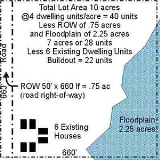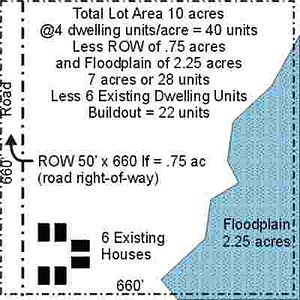
Build-out
Encyclopedia
Build-out is an urban planner
’s estimate of the amount and location of potential development for an area. Sometimes called a "lot-yield analysis", build-out is one step of the land use planning
process. Evaluation of potential development impacts begins with a build-out analysis.
or allocation adds demand factors such as economic growth and the land’s relative attractiveness for new development. Land developers perform build-out calculations to assess the profitability of a parcel of land.
Potential impacts can be derived from build-out by multiplying the amount of development by various factors (e.g. calculating the number of new school children, traffic trips and water demand). Note: the multipliers frequently vary by land use type. These figures only provide the raw demand for these facilities and additional analysis is required (e.g. subtracting existing students from school capacity or a traffic study).
or zoning
assumptions about density to the available land area. The build-out calculation may deduct land due to physical constraints to development (e.g. sensitive natural resources), potential infrastructure dedications (e.g. streets, public open space, or stormwater management structures), and practical design considerations (e.g. lot layout inefficiencies). Existing buildings may reduce the available capacity for new development. Many times these constraints are not known until well after a build-out calculation is performed.
A build-out calculation multiplies the land area by density factors. Residential density is most often expressed as residential dwelling units per acre (DU/ac), but a minimum lot size is also used (especially in zoning). (Note: outside the United States, the metric system usually uses hectares as the area unit of measurement). A floor area ratio
(FAR) typically describes non-residential development, based on the ratio of building floor space to land area, both using the same unit of measure. Additional analysis might estimate the number of buildings or building coverage based on the number of dwelling units per building, the number of stories and/or the building size in square feet.
 A typical analysis of build-out might start with 10 acres (40,468.6 m²) of land with a proposed density of 4 dwelling units per acre.
A typical analysis of build-out might start with 10 acres (40,468.6 m²) of land with a proposed density of 4 dwelling units per acre.
Urban planner
An urban planner or city planner is a professional who works in the field of urban planning/land use planning for the purpose of optimizing the effectiveness of a community's land use and infrastructure. They formulate plans for the development and management of urban and suburban areas, typically...
’s estimate of the amount and location of potential development for an area. Sometimes called a "lot-yield analysis", build-out is one step of the land use planning
Land use planning
Land-use planning is the term used for a branch of public policy encompassing various disciplines which seek to order and regulate land use in an efficient and ethical way, thus preventing land-use conflicts. Governments use land-use planning to manage the development of land within their...
process. Evaluation of potential development impacts begins with a build-out analysis.
Purpose
Performing a build-out analysis identifies the holding capacity of the land. The build-out calculation provides the supply of development for forecasting future land use growth. Land use forecastingLand use forecasting
Land-use forecasting undertakes to project the distribution and intensity of trip generating activities in the urban area. In practice, land-use models are demand-driven, using as inputs the aggregate information on growth produced by an aggregate economic forecasting activity...
or allocation adds demand factors such as economic growth and the land’s relative attractiveness for new development. Land developers perform build-out calculations to assess the profitability of a parcel of land.
Potential impacts can be derived from build-out by multiplying the amount of development by various factors (e.g. calculating the number of new school children, traffic trips and water demand). Note: the multipliers frequently vary by land use type. These figures only provide the raw demand for these facilities and additional analysis is required (e.g. subtracting existing students from school capacity or a traffic study).
Calculation methods
Build-out applies land useLand use
Land use is the human use of land. Land use involves the management and modification of natural environment or wilderness into built environment such as fields, pastures, and settlements. It has also been defined as "the arrangements, activities and inputs people undertake in a certain land cover...
or zoning
Zoning
Zoning is a device of land use planning used by local governments in most developed countries. The word is derived from the practice of designating permitted uses of land based on mapped zones which separate one set of land uses from another...
assumptions about density to the available land area. The build-out calculation may deduct land due to physical constraints to development (e.g. sensitive natural resources), potential infrastructure dedications (e.g. streets, public open space, or stormwater management structures), and practical design considerations (e.g. lot layout inefficiencies). Existing buildings may reduce the available capacity for new development. Many times these constraints are not known until well after a build-out calculation is performed.
A build-out calculation multiplies the land area by density factors. Residential density is most often expressed as residential dwelling units per acre (DU/ac), but a minimum lot size is also used (especially in zoning). (Note: outside the United States, the metric system usually uses hectares as the area unit of measurement). A floor area ratio
Floor Area Ratio
The floor area ratio or floor space index is the ratio of the total floor area of buildings on a certain location to the size of the land of that location, or the limit imposed on such a ratio....
(FAR) typically describes non-residential development, based on the ratio of building floor space to land area, both using the same unit of measure. Additional analysis might estimate the number of buildings or building coverage based on the number of dwelling units per building, the number of stories and/or the building size in square feet.
Example analysis

- A simple multiplication (10x4) would produce a build-out of 40 units.
- A more complex analysis might deduct 0.75 acres (3,035.1 m²) for 660 feet (201.2 m) of 50 feet (15.2 m) road right-of-wayEasementAn easement is a certain right to use the real property of another without possessing it.Easements are helpful for providing pathways across two or more pieces of property or allowing an individual to fish in a privately owned pond...
(ROW). This leaves 9.25 acres (37,433.5 m²) with 37 units allowed. - The land might contain 2.25 acres (9,105.4 m²) of flood plain, a constraint to development. Some communities allow the developer to shift the density elsewhere on the property, keeping the total units at 40. Other communities prohibit density shifting, reducing the target number of units to 31 units.
- Existing structures will limit the number of additional new dwelling units allowed on the land. If an existing subdivision contains 6 dwelling units, the available capacity is 34 units.
- Combining these dwelling unit deductions (40-3-9-6) equals 22 dwellings units for residential build-out.

